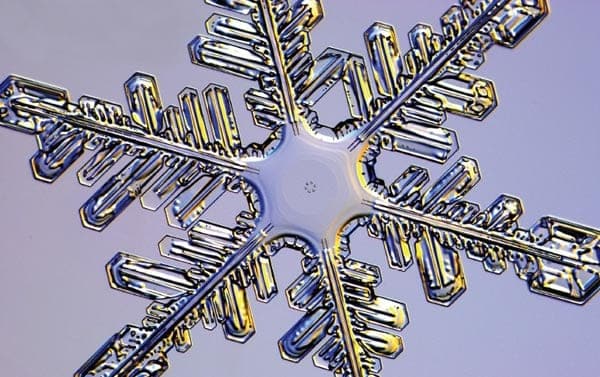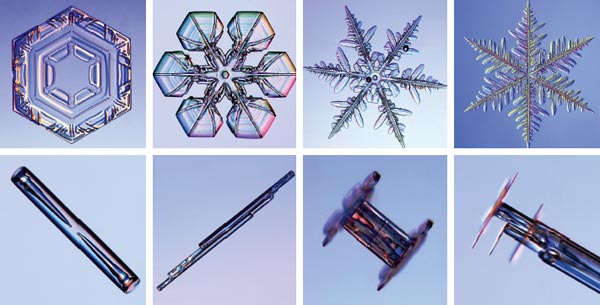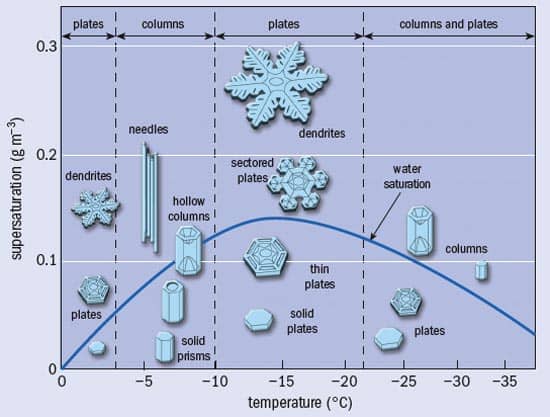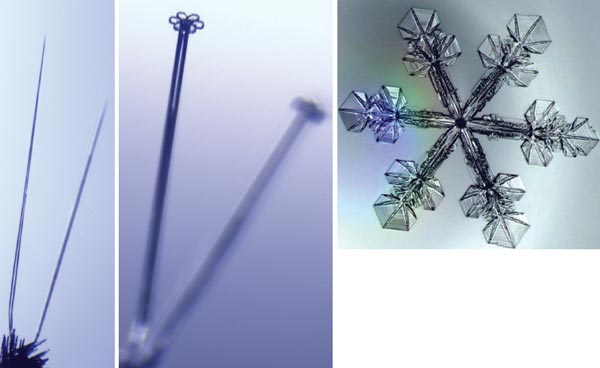The beautiful symmetry of snowflakes masks the complex physics that governs how ice crystals grow and develop under different environmental conditions, explains Kenneth Libbrecht

Sometimes the simple things in nature can be the most puzzling. Take the humble snowflake, that familiar winter icon immediately recognizable by its beautiful structure and distinctive symmetry. One might think that the process whereby water vapour condenses into crystalline ice would be well understood. A closer look, however, reveals that even some very basic questions about how snow crystals form remain unanswered.
In fact, our understanding of crystal growth in general is remarkably primitive compared with our knowledge of crystal structure. Using X-ray scattering at advanced synchrotron light sources, researchers can routinely determine the exact placement of every constituent atom in crystals made from exceedingly complex biological molecules. Yet because we cannot predict exactly how these crystals will grow under different conditions, producing large samples for analysis remains something of a black art.
The underlying difficulty is that crystal growth is a complex problem of molecular dynamics. The macroscopic development and morphology of a crystal — i.e. whether it forms facets or not, how fast it grows under different conditions and whether it develops into a single large crystal or many smaller ones — is governed by the precise way that the constituent atoms jostle into place as they solidify. While the static problem of crystal structure is relatively easy, the dynamical problem of crystal growth is sufficiently difficult that we cannot yet predict the growth behaviour of even relatively simple crystals — including ice.
To reveal the extent of our ignorance, you need little more than a magnifying glass and a gentle snowfall. The variety of snow crystals that you will see is extraordinary (figure 1). For instance, you might first encounter the complex, branched morphologies of stellar snow crystals, which are essentially elaborate thin plates about 50 times thinner than they are wide. In a different snowfall, you might find mostly slender hexagonal columns and needles that are perhaps 20 times longer than they are wide. How can such different forms arise from the same material?

Each column, needle and stellar plate falling from the clouds started out as a simple hexagonal prism — the most basic form of snow crystal — that is defined by two “basal” facets and six “prism” facets. This hexagonal shape, which gives snow crystals their six-fold sym metry, derives from the underlying molecular structure of the ice lattice. But the overall shape of a snow crystal depends on the relative growth rates of the facet surfaces: a columnar crystal forms when water vapour condenses preferentially on the basal surfaces; while plates form when vapour condenses more readily on the prism surfaces. The fact that both columnar and plate-like snowflakes exist means that the ratio of basal and prism growth rates must change by a factor of 1000 under different conditions.
The challenge is to explain how the condensation of water vapour into solid ice can result in such a remarkable variety of crystalline forms. By examining the growth of snow crystals we hope to understand how interactions at the molecular level determine structures at much larger scales. In doing so, we should also gain insights into more general questions about pattern formation and self-assembly in nature.
Crystal morphologies
One of the first people to tackle the science of snowflakes was the physicist Ukichiro Nakaya at the University of Hokkaido in Japan in the 1930s. Nakaya grew his own snowflakes in the lab, which allowed him to study their growth under known conditions. His systematic observations are often summarized in a snow-crystal morphology diagram, which displays crystal shapes as a function of temperature and humidity (figure 2).
Two features in this diagram immediately stand out. First, the crystals become more complex as the humidity increases: simple prisms arise when the humidity is low; while complex, branched forms appear when the humidity is high. Second, the overall morphology behaves peculiarly as a function of temperature, whereby it changes from plate-like to columnar and back again as the temperature is lowered. The latter behaviour has proven particularly difficult to explain, even at a qualitative level. Indeed, after 75 years we still cannot explain why snow crystals grow so differently when the temperature changes by just a few degrees.

In fact, the snow-crystal morphology diagram is but a single 2D slice through a much higher-dimensional “morphology space”. For instance, one could also add a time axis, which would reveal that the crystals become larger and more complex with time, or an axis showing the background gas pressure. In 1975 Takehiko Gonda at the Science University of Tokyo found that growing snow crystals in a low-pressure inert gas results in simple prisms, while higher pressures yield more complex crystals. A comprehensive model of snow-crystal growth could explain all the dimensions of morphology space, but many vital pieces of such a model are still missing. As a result, our investigation of the underlying physics of snow-crystal morphology is very much a work in progress.
The morphology diagram clearly shows that snowcrystal growth depends sensitively on temperature and humidity, and this explains why stellar snow crystals develop structures that are complex yet symmetrical. As a growing crystal descends through the clouds, it encounters different temperatures, humidities and other conditions that affect its growth. The particular path that a crystal follows through the turbulent atmosphere determines its final form, so no two crystals end up exactly alike. However, the six arms of a single crystal all travel together, so they all grow in synchrony. Because the growth is very sensitive to temperature and humidity, each falling crystal develops a unique and intricate structure with a recognizable symmetry.
Diffusion-limited growth
The complexity seen in a snow crystal ultimately arises from the way water molecules are transported to it. As a crystal grows, the surrounding air becomes depleted of water vapour, which must then diffuse in from afar. Water molecules are more likely to diffuse to a protruding point on a crystal, essentially because it sticks out farther into the surrounding humid air. This causes the protrusion to grow more rapidly than other parts of the crystal, which, in turn, increases the relative size of the protrusion. This positive feedback results in a growth instability that produces complex structures spontaneously. In particular, the instability is responsible for the dendritic branching and side branching seen in stellar snow crystals.
In 1947 the Russian mathematician G P Ivantsov discovered a family of dynamically stable solutions to the diffusion equation (a differential equation that describes how the density of a material changes while undergoing diffusion) that shed considerable light on the growth of dendritic structures. The solutions correspond to needle-shaped paraboloids in 3D or simple parabolas in 2D. As diffusion transports particles that condense onto the solid surface, the needles grow longer while preserving their parabolic shapes exactly. In other words, both the radius of curvature of a needle tip and its growth velocity remain constant with time.
With snow crystals, the branch tip of a growing stellar dendrite is a rough approximation of the 2D Ivantsov solution, since the crystal is nearly flat and the tip is roughly parabolic in shape. The branched shape of the dendrite is more complex than a simple parabola, but the added complexity is a relatively small perturbation on the behaviour near the tip. Measurements show that the tip radius and growth velocity are essentially constant with time, just as the Ivantsov solutions predict.
Interestingly, ice forms nearly the same dendritic structures whether it is grown from water vapour in air or from freezing liquid water. In the latter case, the growth is mainly limited by the diffusion of latent heat generated at the solid–liquid interface. In a snow crystal, on the other hand, growth is mainly limited by the diffusion of water-vapour molecules through the surrounding air. The resulting dendritic structures are similar in both cases because both are described by the diffusion equation.
The Ivantsov needles are a family of solutions because any tip radius is mathematically allowed, and for each needle the growth velocity is inversely proportional to the radius. For a given system we therefore need additional physics beyond the diffusion equation to be able to select a single, physical solution from the Ivantsov family. This turns out to be a surprisingly subtle problem that depends on details of the molecular dynamics during solidification. Even this easily measurable macroscopic effect — the tip velocity of a growing dendrite — depends on complex physics at the molecular level.
Growing snow crystals in high electric fields adds an interesting twist to the Ivantsov solutions for diffusionlimited growth. By producing an isolated ice dendrite on the end of a wire, one can easily induce novel growth behaviour by applying a high voltage. As there is a negligible flow of current into the surrounding air, the ice surface quickly becomes charged. As a result, the high field gradients near the electrified dendrite tip enhance the diffusion of the polar water molecules, thus pulling molecules in and increasing the growth rate. (The growth is also affected in important ways by electrically induced changes in the equilibrium vapour pressure.)
Plugging these effects into normal dendrite theory yields a new type of growth instability whereby the tip radius becomes considerably smaller and the needle grows markedly faster above a threshold voltage. Experimentally, this can result in “electric needle” crystals with tip radii as small as 100 nm and growth velocities 10 times faster than normal dendrites. These electrically grown ice needles provide useful pedestals for growing isolated snow crystals in the lab, thus allowing us to make controlled measurements of ice-crystal growth dynamics. Once a needle has been grown and the applied voltage removed, normal growth commences and a single plate-like or columnar crystal forms on the end of the needle (figure 3). As such, the thin ice needle supports the growing crystal while barely perturbing its development.
Digital snowflakes
Although much work has gone into developing an analytical theory of dendrite growth based on the Ivantsov solutions, numerical modelling is necessary to reproduce the complex structures that appear in diffusion-limited growth. This approach is particularly useful when both faceting and branching are present, since the corresponding anisotropy in growth dynamics is not easily included in an analytical theory.

This problem has received considerable attention from metallurgists, since freezing a metal from its melt often produces micro- or even nano-scale dendritic structures that can profoundly affect the strength, ductility and other properties of the final material. To numerically model the solidification process, we must first solve the diffusion equation of the growing surface, then use that solution to propagate the growth, before solving the diffusion equation again with the new solid boundary, and so on. Since errors in each step propagate to all subsequent steps, the challenge is to develop robust computational techniques that include enough relevant physics to model realistic situations.
Several popular numerical approaches have been championed over the years. These include “fronttracking” techniques, which specify the solid–liquid or solid–vapour interface explicitly; “phase-field” techniques, which digitally smooth the interface; and cellular-automaton methods that replace numerical differential-equation solvers (available via commercial software) with a grid of pixels that interact with one another according to well-defined rules. The techniques have different merits, but all have yielded acceptable results for simple dendrite growth. In the case of structures like snow crystals, however, the numerical problems become considerably harder, because the surface dynamics are highly anisotropic.
In 2006 mathematicians David Griffeath at the University of Wisconsin and Janko Gravner of the University of California at Davis, both in the US, showed that cellular automata are especially powerful for solving the problem of snow-crystal growth. The intrinsic anisotropy of the cellular-automata grid, on which individual cells are fixed, seems to stabilize the propagation of numerical errors, although exactly how this works is not yet known. Using this method, Griffeath and Gravner were able to generate the first simulated snow crystals that exhibit complex forms with realistic branching and faceting (figure 4). The underlying surface physics in these models is still somewhat ad hoc, but this recent work appears to provide the long-sought answer to the question of how one can simulate the growth of solids with highly anisotropic growth dynamics.
Subtleties of the surface
The biggest hurdle preventing researchers from constructing a comprehensive model of snow-crystal formation is knowing with certainty the rate at which water molecules condense at the ice surface. This question is vital because the varying growth rates of the basal and prism surfaces are what ultimately determine the temperature dependence seen in the morphology diagram. Unfortunately, so far no-one has been able to measure these growth rates with sufficient accuracy, nor do we have a model of the ice surface that allows us to calculate condensation rates.

Once again, the detailed molecular dynamics of ice make it difficult to observe and model ice surfaces. At temperatures near the freezing point, for example, water molecules in the air bombard the surface at such a rate that a single molecular layer of ice would be deposited every millisecond if the impinging molecules all stuck to the surface. Using molecular-dynamics simulations to model the growth of such agitated surfaces is not feasible, and the molecular motions are too fast to be imaged using scanning probe microscopy.
Fortunately, it is not necessary to comprehend every detail of the surface dynamics in order to model growth behaviour. As is usually the case in condensed-matter physics, one need only possess a reasonably accurate caricature of the underlying physics to make progress. For crystal growth, this caricature is called the “surface attachment kinetics”, where one uses statistical theory to parametrize the growth velocity as a function of temperature, humidity and perhaps other conditions at the surface. The parametrized theory is then constrained using empirical measurements of growth velocities.
Obtaining suitable measurements is surprisingly difficult because one must carefully control the growth conditions to reduce systematic errors. For example, the most accurate measurements are made in low-pressure environments, where the growth is not complicated much by diffusion, and laser interferometry is used to measure the growth rates of individual facets on single, isolated crystals. Researchers are now building up precise measurements of ice-growth rates as a function of temperature, humidity and other parameters, but new puzzles appear as the data improve.
For instance, recent results from my group at the California Institute of Technology show that in these lowpressure environments the prism and basal facets grow at roughly the same rates, with no dramatic dependence on temperature. The data are especially puzzling near a temperature of –15 °C, which is where the thinnest plate-like crystals form. These measurements naively suggest that thin plates would not form at –15 °C, in stark contrast to numerous observations. With these new data, we have only deepened the mystery of the morphology diagram: not only can we not explain the well-known morphological changes with temperature, but now we cannot adequately explain even the formation of thin plates at just one temperature!
There are several ways to reconcile the different observations. One possibility is that the attachment kinetics is strongly affected by the presence of air at the ice surface, which was removed for our growth measurements. Another is that the attachment kinetics depends on the surface structure itself, so that the growth of large facet surfaces differs from the narrow edges of plate-like crystals. Unfortunately, these and other suggestions are all speculative, and to date none has emerged as the correct explanation of the conflicting data sets. How perplexing it is that such a simple phenomenon — the growth of thin, plate-like ice crystals — can be so difficult to understand. For now at least, we are left with the unsettling fact that we still cannot explain, even at a qualitative level, some of the most basic characteristics of snowflakes.
Crystalline conundrums
In many ways, the growth of snow crystals is an excellent case study for the general problem of crystal-growth dynamics. Ice is a relatively simple, monomolecular material with well-characterized intermolecular interactions, and growing ice crystals from water vapour is straightforward and inexpensive. Yet, even simple experiments yield a rich variety of interesting morphologies that cannot be readily understood.
Explaining how snow crystals grow involves a variety of physical processes that take place on a range of length scales. At the small scale, the challenge is to work out the molecular dynamics of growing surfaces and to understand how surface processes vary with temperature and other parameters. At larger scales, one must describe the transport of heat and particles via diffusion and large-scale flows. In order to successfully model morphologies, computational techniques must be developed that incorporate the relevant physics at all these scales. Moreover, trace amounts of chemically active gases have been found to dramatically alter snow-crystal formation, adding a largely unexplored chemical dimension to the morphology diagram.
The lowly snowflake exhibits an impressive phenomenology that stems from the subtle interactions between seemingly simple physical processes. There may be no direct industrial applications for snow crystals, but understanding them requires us to explore fundamental questions about how solids form and how structures arise during crystal growth. This basic research could lead to new discoveries in metallurgy, nano-scale self-assembly and other areas.
However, beyond the intrinsic scientific questions, beyond the practical applications of crystal growth, and beyond the meteorological significance of atmospheric ice, we who ponder snowflakes are motivated by a simple and essential desire to comprehend the natural world around us. These marvellous ice sculptures, so elaborate and beautiful, simply fall from the sky in great abundance. We ought to understand how they are created.



